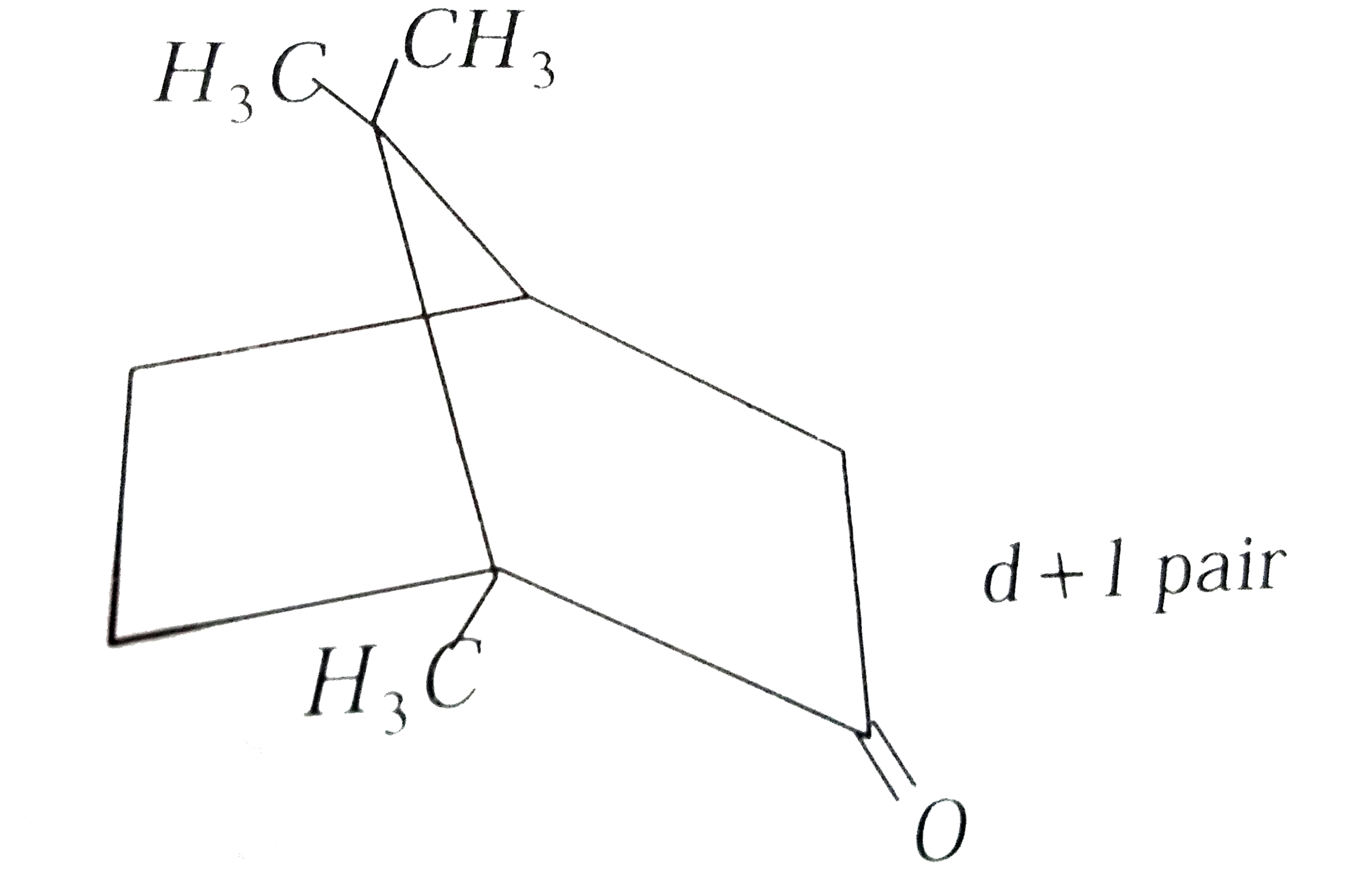Consider all possible isomeric ketones, including stereoisomers, of MW = 100. All these isomers are independently reacted with NaBH4 (NOTE: stereoisomers are also reacted separately). The total number of ketones that give a racemic product(s) is/are
The correct Answer is:5
CnH2nO,Mw=12n+2n+16=100
∴14n=84∴N=6
Six such ketones exist

Thus, 5 such ketones give a racemic mixture
Topper's Solved these Questions
- GENERAL ORGANIC CHEMISTRYBOOK - ERRORLESS CHAPTER - GENERAL ORGANIC CHEMISTRYEXERCISE - Matrix Match type questions
4 Videos
- GENERAL ORGANIC CHEMISTRYBOOK - ERRORLESS CHAPTER - GENERAL ORGANIC CHEMISTRYEXERCISE - Comprehension type questions
6 Videos
- GASEOUS STATE BOOK - ERRORLESS CHAPTER - GASEOUS STATE EXERCISE - JEE SECTION JEE (Advanced) 2018 Numeric answer type question
1 Videos
- HALOGEN CONTAINING COMPOUNDBOOK - ERRORLESS CHAPTER - HALOGEN CONTAINING COMPOUNDEXERCISE - Critical Thinking (Jee (Advanced) 2018)
1 Videos
Similar Questions
Consider all possible isomeric ketones, including stereoisomers of MW = 100. All these isomers are idependently reacted with NaBH4 (Note: stereiosomers are also reacted separately). The total number of ketones that give a racemic product (s) is/are
View SolutionConsider all possible isomeric ketones, including stereoisomers, of MW = 100. All these isomers are independently reacted with NaBH4 (NOTE: stereoisomers are also reacted separately). The total number of ketones that give a racemic product(s) is/are
View Solution
Knowledge Check
Consider all possible isomeric ketons including stereoisomers of MW=100 All these isomers are independently reacted with NaBH4 The total of number of ketones that gives a recemic product (S) is/are
A6B3C5D4Stereoisomerism occurs when the bond connectivity is same but the spatial arrangement of more than one type is possible. Stereoisomerism finds vast use in orgaic chemistry, mainly biochemistry as all the biomolecules, are generally stereospecific in their actions. Stereoisomerism in limited not only to organic compounds but also to anorganic compounds, mainly in co-ordination complexes. Stereoisomers include cis and trans isomers, chiral isomers, compound wilth different conformation of chelate rings and other isomers that differ only in the geometry of attachement of the metal ion.
Select the incorrect statement:Atrans from of [CoCl2(trien)]+ has 3 coplanar chelate ringB[Pt(py)(NH3)(NO2)(Cl)(Br)(I)] has 15 geometrical isomersCCarboxylic group of salicylate ion is cis and tans to tertiary nitorgen in [Co(tren)(sal)]+D[Pt(NH3)2(py)2Cl(2)]2+ complex has 5 non chiral isomer.Stereoisomerism occurs when the bond connectivity is same but the spatial arrangement of more than one type is possible. Stereoisomerism finds vast use in orgaic chemistry, mainly biochemistry as all the biomolecules, are generally stereospecific in their actions. Stereoisomerism in limited not only to organic compounds but also to anorganic compounds, mainly in co-ordination complexes. Stereoisomers include cis and trans isomers, chiral isomers, compound wilth different conformation of chelate rings and other isomers that differ only in the geometry of attachement of the metal ion.
Select the correct option for tertraamminedichlorocobalt (III) ion, the trans isomerAdoes not have any symmetryBhas plane of symmetryCtrans form is meso formDtrans form exists as a pair of ennantiomer
Consider all possible isomeric ketones including stereoisomers of relative molar mass of 100. All these isomers are independently reacted with NaBH4.(Note : stereoisomers are also reacted separately).The total number of ketones that give a racemic products is / are ....... .
View SolutionTotal number of mono-chloro product(s) obtained (including stereo isomers), when isopentane react with chlorine in the presence of sun light?
View SolutionA schematic analysis of the reaction of the enantiomer with racemic mixture is shows below:
d+d and l−−→(d)−(d)The(+)-form ofA racemic mixture of+chiral moleculesother molecules with(d)−(l)50%(d)and50%(l)
The products (d-d) and (d-l) are clearly neither identical nor enantiomers (non-superimposable mirror images) as the diastereomers, stereoisomers that are not mirror images' . The formation of diasteromers allows the separation of enantiomers (called resolution) which is not easy as enantiomers have identical physical properties. One general with naturally occurring chiral molecule to form a pair of diastereomers. These can be separated easily as they have different physical properties. If the original chemical reaction can be reversed, the enantiomers can be isolated.
How many diastereomers are possible among all the possible stereoisomers of 2,3-dibromopentane ?
View SolutionThe smallest ketone and its next homologue are reacted with NH2OH to form oxime.
View SolutionRead the following text and answer the following questions on the basis of the same:
Band theory of solid:
Consider that the Si or Ge crystal contains N atoms. Electrons of each atom will have discrete energies in different orbits. The electron energy will be same if all the atoms are isolated, i.e., separated from each other by a large distance. However, in a crystal, the atoms are close to each other (2 Å to 3 Å) and therefore the electrons interact with each other and also with the neighbouring atomic cores. The overlap (or interaction) will be more felt by the electrons in the outermost orbit while the inner orbit or core electron energies may remain unaffected. Therefore, for understanding electron energies in Si or Ge crystal, we need to consider the changes in the energies of the electrons in the outermost orbit only. For Si, the outermost orbit is the third orbit (n = 3), while for Ge it is the fourth orbit (n = 4). The number of electrons in the outermost orbit is 4 (2s and 2p electrons). Hence, the total number of outer electrons in the crystal is 4N. The maximum possible number of outer electrons in the orbit is 8 (2s + 6p electrons). So, out of the 4N electrons, 2N electrons are in the 2N s-states (orbital quantum number l = 0) and 2N electrons are in the available 6N p-states. Obviously, some p-electron states are empty. This is the case of well separated or isolated atoms.
The maximum possible electrons in an orbit is:
View Solution
